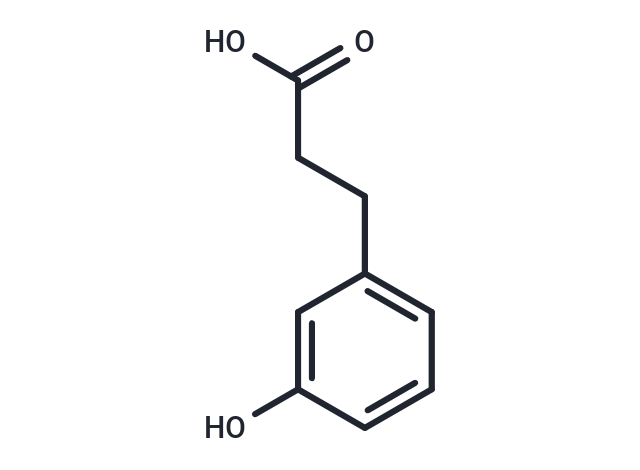Shopping Cart
- Remove All
 Your shopping cart is currently empty
Your shopping cart is currently empty

3-(3-Hydroxyphenyl)propionic Acid (m-Hydroxyphenylpropionic acid) is one of the major metabolites of ingested caffeic acid.it inhibited osteoclastogenesis and bone osteoclastic resorptive activity.

| Pack Size | Price | Availability | Quantity |
|---|---|---|---|
| 500 mg | $29 | In Stock | |
| 1 mL x 10 mM (in DMSO) | $39 | In Stock |
| Description | 3-(3-Hydroxyphenyl)propionic Acid (m-Hydroxyphenylpropionic acid) is one of the major metabolites of ingested caffeic acid.it inhibited osteoclastogenesis and bone osteoclastic resorptive activity. |
| In vitro | 3-(3-hydroxyphenyl) propionic acid (3-3-PPA) and hippuric acid (HA), had dose-dependent suppressive effects on osteoclastogenesis and osteoclast resorptive activity in Corning osteo-assay plates.?Signaling pathway analysis showed that after pretreatment with HA or 3-3-PPA, RANKL-stimulated increase of osteoclastogenic markers, such as nuclear factor of activated T-cells, cytoplasmic 1 and matrix metallopeptidase 9 gene/protein expression were blunted.?Inhibitory effects of HA and 3-3-PPA on osteoclastogenesis utilized RANKL/RANK independent mediators[1]. |
| Cell Research | RAW264.7 cells or nonadherent bone marrow cells were cultured in 96‐well plates (2?×?10^4cells/well) in the presence or absence of 50?ng/ml of RANKL.?Cells were treated with HA at four different concentrations, 0.01×, 0.1×, 1×, and 10×, with 1× equivalent to concentration of 60?μg/dl of HA free form appeared in blood after 10% BB supplemental diet in rats.?Four different concentrations of 3‐3‐PPA or 3‐(4‐hydroxyphenyl) propionic acid (3–4‐PPA), 0.1×, 1×, 10×, and 100×, with 1× equivalent to concentration of 10?μg/dl of 3‐3‐PPA or 3–4‐PPA free form appeared in blood after 10% BB supplemental diet in rats.?After 4 days for RAW264.7 cell cultures and 5 days for bone marrow cell cultures, the cells were ?xed with 4% paraformaldehyde and stained for tartrate‐resistant acid phosphatase (TRAPase) activity using a TRAPase Staining Kit .?TRAP‐positive cells containing >3 nuclei in each well were counted as osteoclasts under an epifluorescent microscope[1] |
| Alias | m-Hydroxyphenylpropionic acid, 3-Hydroxyhydrocinnamic acid |
| Molecular Weight | 166.17 |
| Formula | C9H10O3 |
| Cas No. | 621-54-5 |
| Smiles | OC(=O)CCC1=CC=CC(O)=C1 |
| Relative Density. | 1.260 g/cm3 |
| Storage | Powder: -20°C for 3 years | In solvent: -80°C for 1 year | Shipping with blue ice. | |||||||||||||||||||||||||||||||||||
| Solubility Information | DMSO: 33 mg/mL (198.59 mM), Sonication is recommended. | |||||||||||||||||||||||||||||||||||
Solution Preparation Table | ||||||||||||||||||||||||||||||||||||
DMSO
| ||||||||||||||||||||||||||||||||||||

Copyright © 2015-2025 TargetMol Chemicals Inc. All Rights Reserved.